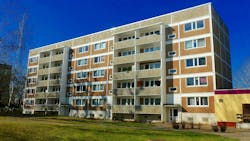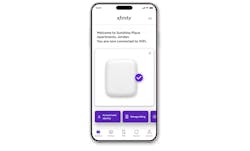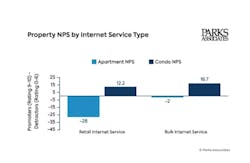Multifamily resident access to gigabit or faster download speeds is rising
Key Highlights
- Nearly 20% of multifamily residents now have gigabit or faster internet, with expectations rising for high-speed connectivity as a standard amenity.
- Bulk internet plans offer cost savings and higher satisfaction, but competitive retail options and existing agreements influence property choices.
- Instant activation solutions like Xfinity's Connected Building enable immediate move-in Wi-Fi, simplifying management and enhancing resident experience.
- Smart technologies, including access control and package management, are increasingly bundled with internet services, impacting fees and property valuations.
- Properties with bulk internet and smart amenities see significantly improved NPS scores, indicating higher resident satisfaction and loyalty.
As broadband service providers extend broadband across a diverse set of older and new properties, it’s clear that gigabit speeds are becoming more prevalent and are becoming an amenity that multifamily residents expect to be ready when they move into a new property.
In a new white paper, A Guide to Connectivity Innovations in Multifamily Housing, in partnership with Cox Communities, Parks Associates research shows that nearly one in five multifamily residents with home internet could get gigabit or faster download speeds.
Parks’ research considers various connectivity options available for multifamily properties, including legacy bulk and retail service, managed Wi-Fi, and the increasingly popular trend of instant activation.
The research found that the expectations in terms of available speeds are increasing. About one in five multifamily residents with home internet reported receiving gigabit or faster downlink speeds as of late 2024. Further, Parks noted that customer satisfaction with home internet is highest among those with these high speeds and lowest among those with low speeds.
Gigabit speeds will be a key consideration. “Gigabit – and even multigigabit – internet will be increasingly important as a resident amenity in the coming years,” Parks said in its study.
Kristen Hanich, director of research for Parks Associates, said that “the owners and operators of multifamily properties must consider the implications of deploying connectivity to new construction versus existing buildings and evaluate their goals, the costs of deployment, and the potential payoff.”
Sizing up retail and bulk internet
Like traditional amenities such as electricity and washer/dryers, broadband access has become an expected amenity.
Multifamily property owners offer services to residents through two main methods: a bulk internet agreement, or residents purchase a retail service.
Defined as either paying an additional amenity fee to a property or receiving internet for free or as part of rent, 10-12% of multifamily residents report having a bulk internet plan.
What is bulk internet?
Bulk internet is a large-scale, wholesale internet service purchased by property owners or home homeowner association (HOAs) from an Internet Service Provider (ISP) for their entire community, like an apartment building or condominium complex. Residents receive the service as an included amenity at a discounted, lower-cost rate than retail plans, providing benefits such as cost savings for residents, dedicated customer support, reliable service, and potential revenue for the property's budget or upgrades.
However, 80-82% report having a retail internet service, which means a resident pays a cable operator or competitive provider for service.
Parks found that there are several cost differences for residents who pay for a retail or a bulk internet plan.
The average apartment renter pays $79 per month for their residential home internet service. Alternatively, those residents who have bulk plans only pay $65 per month, representing an average savings of $14 per month.
One of the anomalies in the multi-family mix is condos. The research firm found that condo owners said they pay higher average costs for both retail internet and bulk internet, but also tend to have higher tiered plans with additional bundled services.
Parks said that “condo owners report higher rates of satisfaction with their home internet than apartment renters do, even though their costs are higher,” but added that “this analysis excludes those whose bulk internet costs are aggregated into their monthly rent.”
Bulk internet has many positive aspects for consumers and property owners. Residents report greater satisfaction with a property, while property owners report they have an easier path to finance smart technology to support resident amenities and operations.
Despite its benefits, Parks noted that “bulk internet is not always the preferred option – existing exclusive marketing agreements as well as a local market with competitive retail internet providers offering low-cost plans, make bulk internet less desirable.”
An alternative to bulk internet is “instant activation, which offers similar benefits, including internet available at move-in, as well as a type of “managed Wifi lite” experience that enables properties to more easily control and manage in-unit smart amenities.
One provider that has been aggressive on the instant activation Wi-Fi front is Xfinity Communities' Connected Building solution, which provides multifamily properties with a property-wide Wi-Fi network, uses the property’s existing infrastructure.
The service provider has continued to advance its instant activation platform. In March, Xfinity launched Connected Building, a networking solution designed to deliver always-on, property-wide WiFi. Residents can access Wi-Fi immediately upon move-in by simply downloading the Xfinity app and following the digital activation process. After they activate their service, they receive a private, in-unit network that they can customize by changing its name and password.
Smart technology’s role
But the MDU broadband market is not just about internet connectivity alone.
Some properties offer residents an option to pay a technology amenity fee that not only includes not just internet, but also in-unit smart technologies, access control, smart gating, and services such as package management.
Parks Associates, in its analysis, saw that the median average cost of these fees at $75 per month for renters and $80 per month among condo owners.
However, the research firm said the cost of these fees varies by what market the property is located.
“There are large differences in fee amounts according to geographic region: Los Angeles, a highly in-demand market, boasts a median tech amenity fee nearly twice as high as the national average,” Parks said. “These fees, as well as installation of the technology generally, help boost overall property NOI and increase valuations.”
Influencing NPS scores
While bulk internet might not be the right fit for every property, Parks saw that properties with bulk internet overall have a higher net promoter score (NPS) than properties that don’t have it today.
The NPS, as of the first quarter of 2025, for apartments overall was -25. Meanwhile, properties without bulk internet on average have an NPS of -28, while adding bulk internet boosts this to -2.
One notable distinction is that NPS for apartments turns positive once bulk internet is combined with smart amenities and smart security features. Finally, while condos have a higher relative NPS of 12, the addition of bulk internet increases the score by several points.
For related articles, visit the Business Topic Center.
For more information on high-speed transmission systems and suppliers, visit the Lightwave Buyer’s Guide.
To stay abreast of fiber network deployments, subscribe to Lightwave’s Service Providers and Datacom/Data Center newsletters.
About the Author
Sean Buckley
Sean is responsible for establishing and executing the editorial strategy of Lightwave across its website, email newsletters, events, and other information products.





